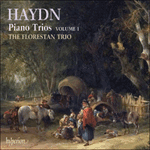In H C Robbins Landon’s majestic series of volumes on Haydn, there is an engraving of a parade in the courtyard of Eszterháza Castle, celebrating the installation of Prince Anton Esterházy as Governor of the County of Oedenburg, on 3 August 1791. Prominently featured is a group of gypsy musicians, with their violins low on their chests in traditional style. Haydn spent most of his working life at Eszterháza, which was in Hungary, and he would regularly have heard gypsy and Hungarian folk music. He often brought touches of it into his own works, and the Piano Trio in G major Hob XV:25 is the most famous example. Its finale incorporates a number of gypsy tunes, including ‘Recruiting Dances’ (
verbunkos). Austrian army officials used to engage groups of gypsy musicians to attract peasants to the recruiting posts with dance-tunes, and Haydn was one of the first composers to weave these into his music. He wrote this trio during the final weeks of his second visit to England in 1795, and its first edition was a great success. The effect of this finale is made all the more striking because it follows two very gentle movements. The first is a set of variations which alternate between major and minor (one of Haydn’s favourite procedures). The second movement is a Poco adagio with, in its central section, a particularly lovely melody for the violin. The cellist Pablo Casals used to take over the repeat of this melody from the violin—a delightful alteration that would not be allowed today.
from notes by Robert Philip © 2009
Dans les somptueux volumes de H. C. Robbins Landon consacrés à Haydn, une gravure représente une parade organisée dans la cour du château d’Eszterháza pour célébrer l’installation du prince Anton Esterházy au poste de gouverneur du comté d’Oedenburg, le 3 août 1791. Bien en vue, des musiciens tziganes portent leur violon dans le style traditionnel, en position basse sur leur poitrine. Tout au long de sa carrière passée presque exclusivement à Eszterháza, en Hongrie, Haydn entendit de la musique folklorique tzigane et hongroise, dont il émailla souvent ses œuvres, la plus célèbre étant le Trio avec piano en sol majeur Hob XV:25. Son finale intègre plusieurs airs tziganes, notamment des
verbunkos, ces «danses de recrutement» que jouaient des musiciens tziganes engagés par les représentants de l’armée autrichienne pour attirer les paysans vers les postes de recrutement et que Haydn fut parmi les premiers à insérer dans sa musique. La première édition de ce trio écrit dans les dernières semaines de son second séjour anglais (1795) remporta un vif succès. L’effet du finale est d’autant plus saisissant qu’il survient après deux mouvements très doux. Le premier est une série de variations alternant entre majeur et mineur (l’un des tours favoris de Haydn). Le second est un Poco adagio qui, en sa section centrale, offre au violon une mélodie particulièrement charmante. Le violoncelliste Pablo Casals avait pour habitude de la répéter à la suite du violon—une savoureuse modification qu’on n’admettrait plus aujourd’hui.
extrait des notes rédigées par Robert Philip © 2009
Français: Hypérion
In H. C. Robbins Landons ansehnlichen Bänden über Haydn findet sich ein Stich, der eine Parade auf dem Hof des Schlosses Eszterháza darstellt, in der die Einsetzung von Fürst Anton Esterházy als Majoratsherr des Ödenburgerlands am 3. August 1791 gefeiert wird. In prominenter Position befindet sich eine Gruppe von Zigeunermusikern mit ihren Geigen im traditionellen Stil auf die Brust gesetzt. Haydn verbrachte die meiste Zeit seines Arbeitslebens in Eszterháza in Ungarn und hörte wohl regelmäßig ungarische und Zigeunermusik. Er brachte oft Anklänge daran in seine eigenen Werke ein; das Klaviertrio in G-Dur Hob XV:25 ist das berühmteste Beispiel dafür. Sein Finale integriert eine Anzahl von Zigeunerweisen einschließlich militärischer „Werbungstänze“ (
Verbunkos). Österreichische Armeeoffiziere engagierten damals Gruppen von Zigeunermusikern, um Landleute mit ihren Tanzmelodien zu Rekrutierungsposten zu locken, und Haydn war einer der ersten Komponisten, die sie in ihre Musik einwoben. Er schrieb dieses Trio während der letzten Wochen seines zweiten Englandbesuchs 1795, und die Erstausgabe war ein großer Erfolg. Der Effekt dieses Finales ist umso erstaunlicher, als es zwei ganz zarten Sätzen folgt. Der erste ist eine Folge von Variationen, die zwischen Dur und Moll abwechseln (eines von Haydns Lieblingsmitteln). Der zweite Satz ist ein Poco adagio mit einer besonders anmutigen Melodie für die Violine im Mittelabschnitt. Der Cellist Pablo Casals übernahm in der Wiederholung gewöhnlich diese Melodie an Stelle der Violine—eine bezaubernde Änderung, die heute nicht erlaubt wäre.
aus dem Begleittext von Robert Philip © 2009
Deutsch: Renate Wendel


 Haydn: Piano Trios, Vol. 1
Haydn: Piano Trios, Vol. 1
